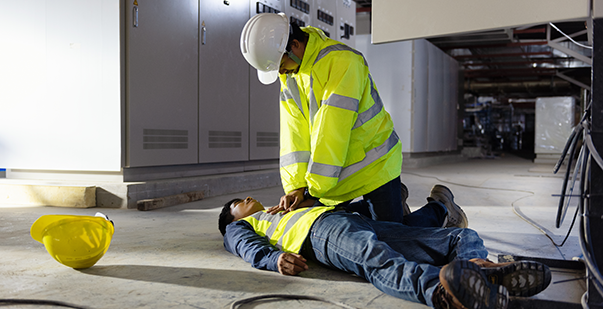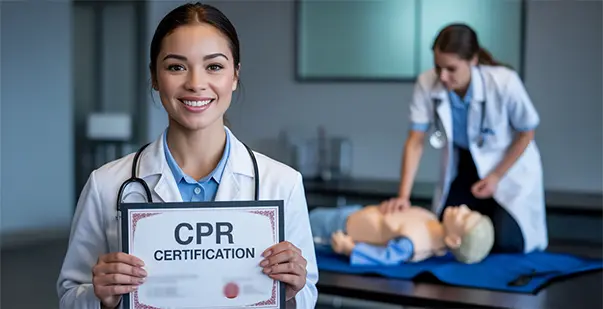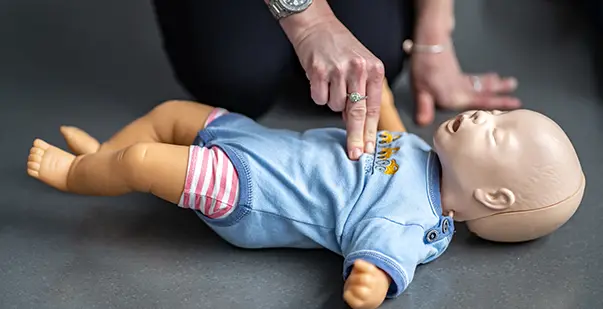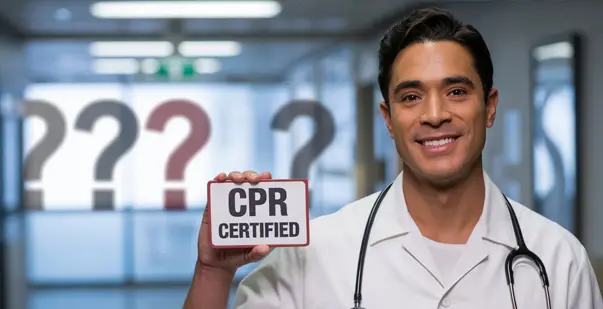Have you ever wondered if you could save someone’s life in a crisis? Cardiopulmonary Resuscitation is a life-saving skill that can make all the difference when every second counts. While CPR is often associated with chest compressions, it’s about knowing the right steps to take and performing them with precision.
According to a study published in StatPearls, coronary artery disease (CAD), a major cause of cardiac arrest, accounts for roughly 610,000 casualties annually in the United States. Globally, CAD is liable for approximately 17.8 million casualties each year, making it the third greatest cause of mortality globally. In this blog, we’ll explore what CPR certification is, why it matters, how the training works, and how you can take the first step toward being prepared to save a life.
Read More: How Long Does CPR Certification Last? Duration & Renewal Options
What is CPR Certification?
In the U.S. alone, healthcare services connected to CAD cost over $200 billion yearly. The good news? Despite its impact, CAD and related cardiac events are often preventable, and knowing CPR is one of the most powerful tools in responding to such emergencies.
CPR certification is awarded to individuals who complete a training course that teaches them how to perform CPR correctly in an emergency situation. A person who is CPR certified has been trained to assess a situation, perform chest compressions, administer rescue breaths if necessary, and use an AED (Automated External Defibrillator) to revive someone in a life-threatening situation.
The primary CPR certification meaning here is that it proves the individual has passed a specific set of tests, which shows both their knowledge and practical ability to provide effective CPR.
Read More: CPR Best Practices for Physicians and Nursing Staff
What Are the Major Types of CPR Certification?
Apart from knowing what CPR certification is, you also need to remember that this certification is not one-size-fits-all. The type you need depends on who you are and what you do. A nurse, a school teacher, and a construction worker won’t take the same course because each faces different situations and responsibilities in an emergency. Some certifications focus on basic skills for the general public. Others go deeper, covering advanced life support for healthcare professionals. There are also options designed specifically for workplace responders or those caring for children. Below is a breakdown of the most common CPR certification types and who they’re best suited for.
Certification Type | Ideal For | What It Covers | Course Duration | Certification Validity |
Basic CPR/AED | General public, teachers, parents, fitness trainers, and office workers | | 2–4 hours | 2 years |
BLS (Basic Life Support) | Healthcare professionals: doctors, nurses, EMTs, hospital staff | High-quality CPR for adults, children & infants Use of bag-valve-mask devices AED use in clinical settings Team CPR dynamics and multi-rescuer skills
| 4–6 hours | 2 years |
Pediatric CPR & First Aid | Childcare workers, teachers, nannies, babysitters, parents | CPR for infants & children Choking relief- Pediatric AED use First aid for burns, cuts, allergic reactions, etc. Child safety essentials
| 2 hours 30 minutes | 2 years |
Heartsaver CPR/AED | Workplace responders, community groups, and volunteers with no medical background | CPR and AED for adults & children Basic emergency response steps Optional first aid module
| 2–3 hours | 2 years |
CPR/First Aid Combo | General safety preparedness in homes, offices, or schools | CPR + basic first aid (bleeding, burns, sprains, seizures, etc.) AED usage Scene safety and injury assessment
| 3–6 hours | 2 years |
Wilderness CPR | Hikers, outdoor guides, adventure sports instructors | CPR in remote areas- Improvised first aid Prolonged care when help is delayed- Hypothermia, bites, altitude sickness
| 8+ hours | 2–3 years |
Read More: Need of CPR Programs for Schools & Teachers
What is Covered in a CPR Certification Course?
By now, you’re aware of what CPR certification is, but you also need to know how to perform CPR. This is a simple yet crucial technique, and it involves several steps that must be followed carefully. According to the AHA, cardiac arrest victims who receive bystander CPR within two minutes have around an 81% chance of surviving and being discharged from the hospital. These individuals also have a 95% chance of surviving without getting brain damage. The process can be broken down into these main steps:
1. Assess the Situation
You’ll first learn how to check for signs of life safely. Tap the person’s shoulder and loudly ask if they’re okay. If there’s no response, quickly check for breathing. Call 911 or send someone to get help right away.
2. Start Chest Compressions
Position the person on their back on a firm surface. Kneel beside them and place one hand on the center of their chest, right over the sternum. Place your other hand on top of the first, interlacing your fingers. Lock your elbows and begin pushing down hard and fast, with at least 2 inches of depth and a rate of about 100 to 120 compressions per minute.
3. Rescue Breaths (if trained)
If you are trained in rescue breathing and feel comfortable doing so, give two full breaths after every 30 chest compressions. Tilt the victim’s head back to open the airway and pinch their nose. Place your mouth over theirs and give a breath, ensuring the chest rises. Continue with chest compressions and rescue breaths in a 30:2 ratio.
4. Use of AED (Automated External Defibrillator)
If an AED is available, turn it on and follow the device's prompts. The AED will analyze the person’s heart rhythm and will deliver a shock if necessary to restore a normal rhythm. AEDs are designed for easy use by anyone, even those without medical training.
5. Continue CPR
You’ll be trained to continue CPR, compressions and breaths, until emergency responders arrive or the person begins to move or breathe. The course emphasizes staying calm and consistent to give the victim the best chance at survival.
Are You Legally Protected When Performing CPR?
If you’ve ever hesitated to help someone in a medical emergency out of fear you might “get in trouble,” you’re not alone. The good news is that most U.S. states have Good Samaritan Laws that protect people who provide emergency assistance in good faith. These laws are designed to remove the fear of legal liability and encourage bystanders to step in and help during life-threatening situations like cardiac arrest.
Here’s what these laws typically cover:
As long as you act responsibly and try to help someone, you probably won’t get into legal trouble. If you use an AED or do CPR correctly, even if you’re not fully certified, the law usually protects you. You won’t be blamed for accidental harm if you were honestly trying to help, not cause harm. Still, since laws can be different depending on where you live, it’s smart to learn your state’s rules, especially if you’re getting certified or work in public safety.
Read More: The 10 Benefits of CPR Certification for Construction Workers
Transform Your Ability to Help: Get CPR Certified Today!
The CPR certification meaning is a lot more than just a course; it is a life-saving skill that can make the difference between life and death in critical situations.
When you know the steps of CPR and why it's important, you're more ready to help in an emergency. Quick action can save a life. If you haven’t gotten CPR certified yet, now is a great time to take a Healthcare CPR/AED + First Aid course. It might be one of the most valuable things you ever learn.
References:
https://cpr.heart.org/en/courses/basic-life-support-course-options
https://www.redcross.org/take-a-class/cpr/cpr-training?
https://www.redcross.org/take-a-class/classes/adult-and-pediatric-first-aid
https://elearning.heart.org/course/1164/












